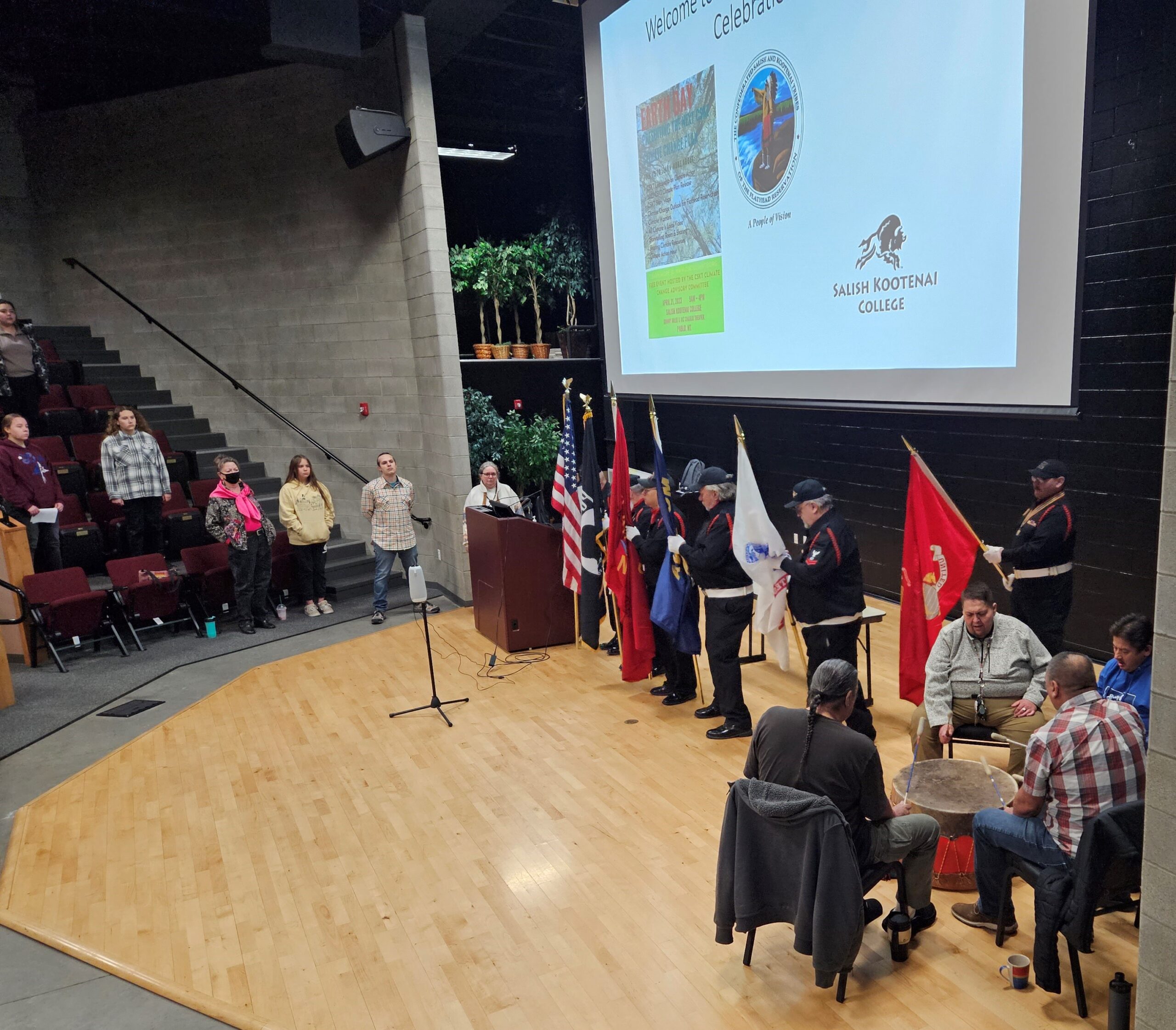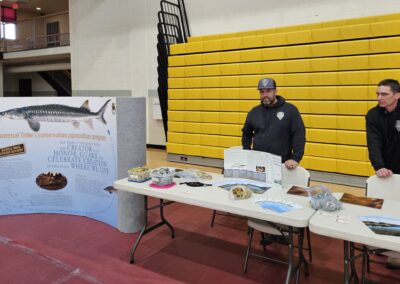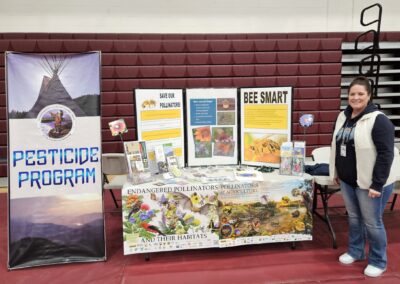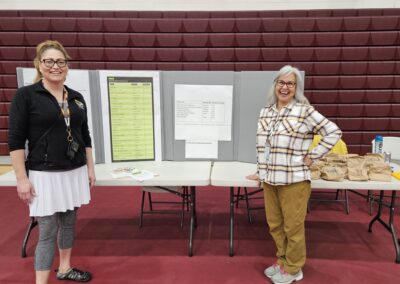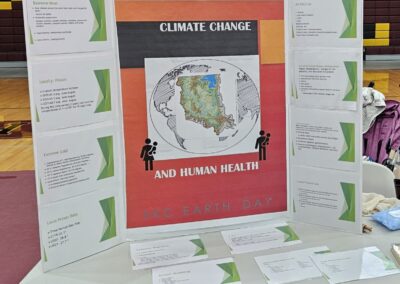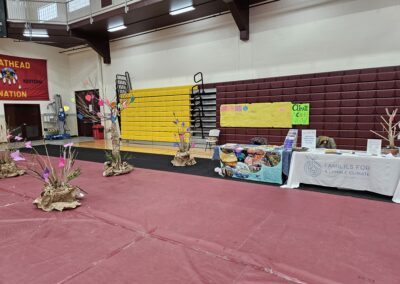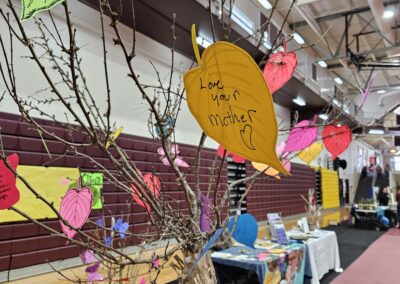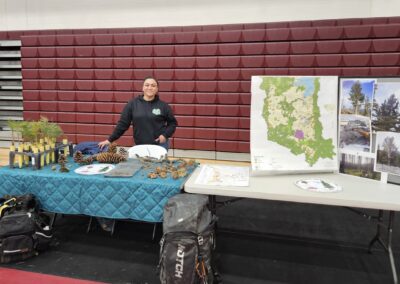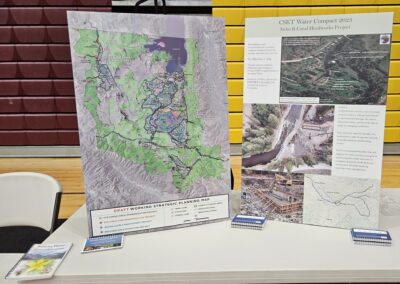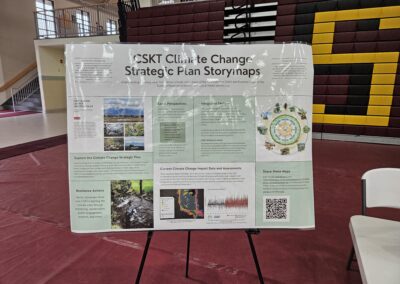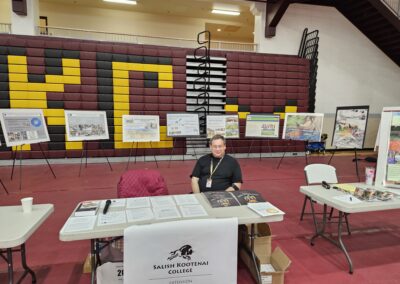The Confederated Salish and Kootenai tribes have maintained a reciprocal and respectful relationship with the lands, waters, and wildlife of Northern Montana since time immemorial, but the climate crisis is threatening their traditional homelands. The CSKT’s Earth Day celebration on April 21, 2023 honored their longstanding relationship with the environment while confronting climate challenges and calling for swift and decisive action. The day-long event at Salish Kootenai College included presentations from CSKT tribal leaders, student groups, and members of the Native Climate team in the morning, followed by an afternoon session where attendees were encouraged to independently explore booths showcasing climate action in the Fitness Center. Guests reconvened for the final hour to share their strategies to fight for a better climate future.
Read on to learn about the climate actions of the Confederated Salish and Kootenai tribes, along with the most important lessons from this event.
Sharing knowledge, sharing stories
Presentations in the morning emphasized the scale of the climate crisis and the urgency of taking action. After an opening ceremony featuring drumming, a colorguard, and a moving prayer by elder Steven Smallsalmon, CSKT tribal chairman Tom McDonald delivered opening remarks, highlighting the threat of water pollution posed by mining projects upstream in Canada. Mike Durglo, Jr. and Maureen McCarthy introduced the latest version of the CSKT Climate Change Strategic Plan, a document drafted to guide adaptation and climate resilience. In addition to the written document and CSKT Climate website, communications designer Annika Mayer presented a set of interactive storymaps which showcased the plan along with current adaptation efforts and the climate science behind them. Climatologist Kelsey Jencso of the Montana Climate Office then presented on climate outlooks specific to the Flathead Reservation, using the latest available data and focusing on local impacts.
The younger generation was a major focus of the morning’s presentations as well, with a timely update on the Held v. Montana case for climate justice and presentations on local climate impacts from Native Climate’s student All Climate is Local projects. Although the climate outlooks discussed earlier in the morning were very serious, it was clear that this generation is willing and able to take action to secure a better future.
Pathways to Climate Resilience
In the afternoon, Earth Day attendees explored booths presented by a variety of tribal and environmental organizations in the Fitness Center. This format encouraged visitors to have open conversations with climate and environmental professionals about the impacts of climate change on their lives, sharing observations, experiences, and questions. Booths included subjects such as the CSKT Climate Change Strategic Plan storymaps, Air Quality Curriculum, Tribal Food Sovereignty, Tribal Health, the pesticide program, forestry on the Flathead Reservation, fish, Flathead Lakers, and Families for a Liveable Climate. View the slideshow below to virtually explore the booths at the Earth Day celebration.
Earth Day Virtual Tour
Explore the gallery to see the different booths presented at CSKT’s Earth Day Celebration.
Kootenai Tribe Conservation Aquaculture
Display by the Kootenai Tribe’s Conservation Aquaculture Program. This exciting program focuses on the restoration of various culturally significant fish like sturgeon and burbot, fostering healthy river habitats and maintaining a native fish hatchery.
Pesticides and Pollinators
Pesticide and pollinator informational booth with details on the importance of pollinators to agriculture and ecosystems. Visitors could take away multiple informational resources, along with packets of pollinator-friendly Montana seeds to plant in their own gardens.
Healthy eating
Tribal Health display on healthy eating. Visitors were provided with a bag of locally grown, nutritious lentils and a recipe for lentil curry alongside information on maintaining balanced diets.
Climate change and human health
Poster detailing the impacts of climate change on health in tribal communities, especially the increasing threats posed by extreme temperatures, vector-borne diseases, and air pollution. Adapting to the ever-evolving risks posed by climate change is a priority for Tribal Health.
Flathead Lakers and Families for a Liveable Climate
Trees by the Flathead Lakers. Attendees wrote their future climate wishes and hopes on the tree leaves to envision a better future. Beside them, Families for a Liveable Climate presents their climate hopes tree as well.
CSKT Forestry
Shinaasha Pete of CSKT Forestry presents the whitebark pine restoration project. The display includes equipment for caging the pines, along with examples of the cones, photos, and a map of restoration areas. After exploring the display, she encouraged visitors to take home a Ponderosa sapling to plant.
CSKT Water Compact
Water department maps presented by Casey Ryan. The display highlights infrastructure upgrades made possible by the water compact and features booklets of aquatic invasive species of Montana to look out for on the Reservation.
CSKT Climate Change Strategic Plan Storymaps
Climate Change Strategic Plan Storymap poster. Beside the poster, the storymaps were displayed on a large monitor where attendees could further explore the climate plan. Viewers were also encouraged to fill out a survey about the effectiveness of the storymaps.
Air Quality Curriculum
Ileah Kirchoff of DRI presented Native Climate’s Air Quality curriculum, designed to help students understand the impacts of smoke and build their own air filters.
Putting words into Action
Between informal conversations, presentations, prayers, and posters, attendees had spent the day facing the harsh realities of a changing climate and its undeniable impacts on the Flathead Reservation. If all those challenges seemed overwhelming, the last hour of the day provided much-needed hope for the future by encouraging participants to share how they planned to change their individual lives to ensure a more sustainable climate future. The session included an exchange of promises between the under 40s and over 40s to preserve and protect the environment across generations. Speakers emphasized the importance of individual commitments to a low-carbon lifestyle, but also the importance of political action to encourage those in power to make the environment a priority.
Make your commitment to a low-carbon future or submit your comments and suggestions by filling out the survey here:
Event Highlights
-
Intergenerational connections: The audience in the theater spanned multiple generations, with the youngest participants in their teens and the oldest in their eighties. From elder Steven SmallSalmon to the EAGLES students who presented on climate actions at their highschools, everyone in attendance agreed on the necessity of swift action on the climate crisis.
-
Impactful Climate Action: Presentations and booths focused on real, tangible actions which individuals and organizations have undertaken to address the climate crisis, from planting pollinator-friendly gardens to pursuing legal action against the state of Montana secure rights to a clean and healthful environment. The result was both inspiring and empowering, with examples and advice for future climate action initiatives.
-
Celebration of Culture: From the event’s opening with the Sn Yel Mn drum to local bison burgers, the vibrant culture of the Confederated Salish and Kootenai tribes was an essential part of the Earth Day event. Although the crowd was diverse, the messages of the day were based firmly in tribal values of a balanced relationship with the environment. It was a valuable chance for indigenous voices to speak about their own lands and history, and for people of all backgrounds to listen.
The message delivered at Salish Kootenai College, at the foot of the formidable Mission Mountains and downstream from Flathead Lake, was clear: the climate is changing and it is our responsibility to protect our world. For the younger people attending the event, it was a reminder of the hard work done by past generations and a call to keep fighting to preserve the lands, water, air, and wildlife which have sustained people for so long. For the older generation, it was a time to reflect on past actions and to consider how the planet could be protected for the future. If individuals, communities, and institutions follow the example of resiliency shown by the Confederated Salish and Kootenai tribes, the planet may have a brighter climate future.

